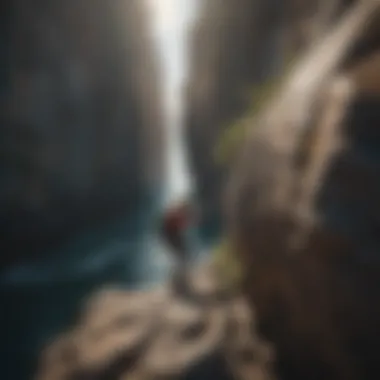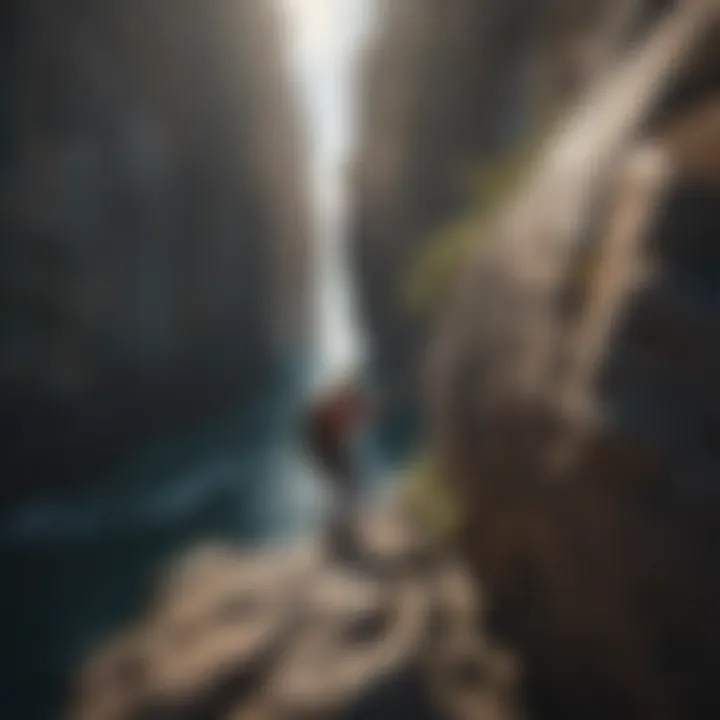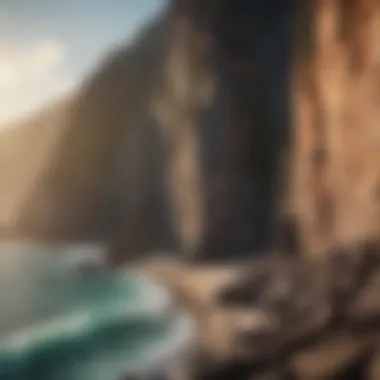Coastal Climbing: Experience Nature's Edge


Intro
Coastal climbing is not just a sport; it’s an adventure that beckons to the heart of thrill-seekers. Imagine scaling cliffs that jut out against crashing waves, experiencing the salty air while pushing your limits. In recent years, more climbers have been flocking to coastal routes, captivated by the unique challenges and breathtaking views that only this environment can offer.
With each climb, opportunity for growth presents itself. The blend of rock formations, tides, and wind creates a space where nature truly tests your skills, demanding more than just physical prowess. Proper technique and safety considerations transform a typical climbing journey into a comprehensive experience that integrates skill development with community engagement.
The coastal climbing scene boasts its own vibrant culture. It’s not merely about reaching the summit; it’s about the stories shared, the friendships forged, and the respect for the natural world that is instilled in every climber. As you immerse yourself in this world, you'll discover new perspectives and knowledge which will enhance your understanding of climbing.
Additionally, there are practical aspects to explore—such as gear selection and safety measures—that are crucial for novices and seasoned climbers alike. This narrative will guide you through essential techniques, gear recommendations, safety tips, and insights into the community surrounding coastal climbing, easing your journey into this captivating pursuit.
So strap on your harness and get ready! Let us delve into the world of coastal climbing and uncover what makes it such a thrilling adventure.
Understanding Coastal Climbing
Coastal climbing combines the challenges of traditional rock climbing with the unique conditions offered by coastal environments. As an adventure sport, it is not just about reaching new heights; it's also a way to engage with nature in a strikingly different context. Understanding this is crucial, as it lays the foundation for what makes climbing near coastlines both exhilarating and perilous. Climbing enthusiasts are drawn to the diverse landscapes and breathtaking vistas. The importance of grasping the nuances of this activity cannot be overstated, as it aids climbers in honing their skills, enhancing their safety practices, and appreciating the intricate beauty of coastal ecosystems.
Definition and Overview
When we talk about coastal climbing, it refers to scaling rocks, cliffs, and formations found along coastlines. This means not only cliffs made of granite or limestone but also rugged formations shaped by years of erosion from the sea. Think about the unpredictable weather, sudden tidal shifts, and the varying difficulty levels presented by different rock faces. All of these factors necessitate a unique set of skills and knowledge. Coastal climbing can take place in locations such as the towering cliffs of California, the dramatic coastlines of Scotland, or the serene rock platforms in Australia. In each of these places, climbers encounter a blend of beauty and challenge, making each ascent an adventure in its own right.
Historical Context
The roots of coastal climbing can be traced back to the mid-20th century, when climbers began seeking new and exciting locations apart from the traditionally favored mountainous regions. Pioneers in the sport recognized the potential of cliffs overlooking the oceans, often finding that these areas offered diverse climbing experiences ranging from bouldering to multi-pitch climbing. Over the decades, coastal climbing has gained traction as avenues for exploration expanded, with climbers documenting their journeys through various media. This led to the establishment of climbing communities dedicated to sharing knowledge and experiences specific to this niche, while also raising awareness about conservation efforts pertinent to fragile coastal environments.
Characteristics of Coastal Climbing
Coastal climbing features several unique characteristics that set it apart from other forms of climbing. Here are a few of the most notable aspects:
- Dynamic Weather: Climbers must adapt to rapidly changing weather conditions. Fog, rain, or sudden winds play a significant role in planning climbs.
- Tidal Changes: The influence of tides can dramatically affect climbing routes. Climbers must be aware of the tide schedule to avoid becoming stranded or thwarted by rising waters.
- Geological Variety: Coastal areas exhibit a diverse array of rock types, from sandstone to basalt, each presenting unique climbing challenges.
- Marine Life Interaction: The proximity to ocean ecosystems means climbers may encounter wildlife, which, while magnificent, can also pose varying degrees of risk.
In summary, understanding coastal climbing equips enthusiasts with the knowledge they need to approach this thrilling activity with both enthusiasm and caution. The excitement of conquering a cliff while hearing the rhythmic waves crashing below is unmatched, but the process requires respect for both natural and safety considerations.
Unique Features of Coastal Climbing
Coastal climbing doesn’t just offer a trek up some rocks; it provides a symphony of nature’s elements playing out beneath climbers’ fingertips. From the textures of the cliff face to the relentless rhythm of the waves below, the distinct characteristics of coastal climbing elevate it into a category all its own. Understanding these unique features is essential for both safety and enjoyment, making climbers well-prepared to navigate the challenges that coastal environments present. Additionally, a grasp of these features promotes a deeper appreciation for the coastal experiences that adventure-seekers crave.
Geological Aspects
When it comes to coastal climbing, the geology is pretty much the star of the show. As you observe crags and cliffs, you can't help but notice the different rock types that paint the landscape. Many coastal regions boast striking formations, like granite cliffs or limestone arches, shaped by millions of years of geology and erosion.
These geological features can significantly impact climbing routes. For instance, granite often provides better friction, allowing for more delicate foot placements, whereas limestone can have sharp holds that demand good finger strength. There’s also the aspect of tide pools at the base of cliffs full of life, like sea anemones or colorful starfish, which changes the surroundings climbers have to interact with.
The unique blend of rocks and formations means climbers should have an eye for detail and adaptability – the geological history leads not just to spectacular views, but also to unique routes and challenges.
Flora and Fauna Considerations
What sets coastal climbing apart is not only how climbers ascend but also the wildlife that thrives in these niches. The ecosystems found in coastal settings are vibrant, definitely not your average forest or mountain terrain.
Climbing near sandy beaches or rocky shores means sharing the paths with wildlife. Birds are in abundance along the cliffs, often providing up-close views of nests or fledglings. Plus, there’s the vegetation, which can vary dramatically from one location to another. Heavy coastal winds and salt spray create a unique flora, often characterized by resilient plants like sea oats and hearty succulents.
Climbers must tread lightly, as some rare plants can be easily damaged. Respecting the local ecosystems isn’t just good ethics; it ensures climbing routes remain in good shape for future adventurers. In short, being mindful of the flora and fauna enriches the climbing experience while contributing to environmental stewardship.
Tidal Influence
Imagine the thrill of clinging to a cliff with waves crashing below. The tidal influence is another essential feature of coastal climbing, defining the rhythm of the experience. Tides have a significant bearing on climbing conditions. Generally, climbers need to be astutely aware of tidal schedules to ensure safe access to the base of cliffs and to avoid being trapped by incoming water.
Knowing the tides allows climbers to time their ascents perfectly. For some routes, climbing at low tide can reveal hidden holds or offer less wave fatigue. Conversely, climbing during high tide can present hazards, such as massive waves crashing on rocks or covering paths that are usually safe.
"Tidal schedules are as critical as mastering your knots when it comes to coastal climbing. Ignoring them is like playing with fire."
Whether it’s planning ascents around tides or simply enjoying the ever-shifting scenery, climbers must be attuned to this natural power. It isn’t just about the climb; it’s about harmonizing with the coastal environment.
Essential Techniques for Coastal Climbing


In the realm of coastal climbing, proficiency in essential techniques can spell the difference between a successful ascent and a precarious situation. This segment sheds light on the intricate methods that climbers must master to navigate the unique challenges of coastal environments. As climbers scale rock faces adorned with salt-kissed lichen or maneuver around tidal pools, a solid grasp of these techniques not only enhances safety but also augments the overall experience of the climb.
Climbing Techniques
The heart of coastal climbing lies in specialized climbing techniques tailored for the unique rock formations found along coastlines. Different types of rock have varying levels of grip, and it’s crucial to adapt your climbing style accordingly. For instance, smearing can often be more effective on the slippier granite when wave action has smoothed the surface. Finding the right footing, securing handholds, and utilizing features like cracks or overhangs are all part of the climber's toolkit. These techniques must be executed proficiently, as the dynamics of weight distribution on a coastal climb differ significantly from traditional climbing—factors like sudden gusts of wind or shifting tides introduce additional challenges.
Some essential techniques include:
- Mantling: Pressing down on top of a ledge to hoist yourself up.
- Heel hooking: Using your heel on a hold to gain leverage.
- Laybacking: Pulling with your hands while pushing against a vertical feature with your feet.
Each-method has its moments where it shines, so climbers must remain versatile and be nimble thinkers under the sun or rain.
Navigation and Route Finding
In coastal climbing, the right route is as critical as the climb itself. Navigating effectively can mean the difference between a smooth ascent and an arduous detour around impassable sections. The cliffs can be deceptive; what appears to be a straightforward path may conceal a world of unexpected challenges.
Effective navigation starts with a proven understanding of the topography. Familiarizing oneself with detailed topographic maps and engaging with climbing guides or local experts can provide invaluable insight into the area. One must also consider the tidal movements, as certain routes may become treacherous when the tide rolls in. Understanding tide charts and timing your climbs around low tide often unlocks new possibilities and safe routes.
Additionally, using landmark-based navigation techniques can aid in orientation; familiar landmarks on the coastline can serve as vital reference points. One may even choose to carry a compass or GPS device, although old-school techniques are sometimes just as effective.
Here are some tips for effective navigation:
- Study Topographic Maps: Know the cliffs and surrounding areas.
- Use Landmarks: These can help orient your route.
- Tide Charts: Plan your climb around tidal shifts for safety.
Environmental Adaptability
Coastal climbing is not just a test of skill; it demands a deep adaptability to the environment. Climbers must embrace the ever-changing conditions that coastal areas present, from shifting sands to unpredictable weather. A comprehensive understanding of the local ecosystem can bolster a climber’s ability to respond to challenges—be it a sudden squall or a patch of slimy moss underfoot.
Having an adaptable approach means being ready for anything. For example, weather patterns can shift rapidly, and getting caught off guard can quickly turn a fun outing into a dangerous situation. Monitoring weather forecasts before and during a climb helps climbers prepare for any eventuality. Similarly, understanding the impact of local wildlife—like seabirds or tidal creatures—means knowing which areas to avoid or respect.
Being adaptable also extends to gear choices; appropriate shoes, for instance, should provide good traction in wet or slippery conditions. Recognizing that conditions can vary dramatically from hour to hour requires climbers to stay vigilant and adjust on the fly, without getting flustered.
In summary, some key points to environmental adaptability are:
- Monitor Weather: Keep an eye out for changing patterns.
- Be Aware of Wildlife: Respect local fauna and flora.
- Gear Adaptability: Choose the right equipment for varying conditions.
"In climbing, nature's voice is loud, echoing even in the silence of the rocks. Listen closely, and you're sure to find the right path to take."
With these techniques at the forefront of your climbing practice, embarking on an adventure along the coast will be not just safer but also a richer experience.
Gear and Equipment Necessities
When it comes to coastal climbing, having the right gear can mean the difference between a refreshing day of adventure and a trip that turns perilous in a heartbeat. The coastal environment presents unique challenges that climbers must navigate. From slippery rocks to sudden weather shifts, being equipped with the right tools is not just beneficial, it's required. With proper gear, climbers can enhance their performance and minimize risk, making their experience both thrilling and safe.
Recommended Gear
Choosing the appropriate gear for coastal climbing is critical. Here’s a breakdown of what you’ll need to conquer those rugged cliffs while ensuring your safety:
- Climbing Shoes: Opt for shoes with excellent grip, as you’ll often find yourself scaling wet, slippery surfaces. A snug fit can make all the difference in stability.
- Harness: A comfortable and adjustable harness is essential for securing yourself during climbs. Look for one that allows for freedom of movement but still keeps you safe.
- Rope: Invest in a dynamic rope that’s treated for abrasion and wet conditions. Coastal climbing can wear out ropes more quickly, so this one's a game changer.
- Carabiners: Steel carabiners are recommended for coastal areas, as they handle wear-and-tear from saltwater and moisture better than aluminum.
- Chalk: Don’t underestimate the power of good chalk; it helps keep your hands dry, improving grip in humid conditions.
These items form the backbone of your climbing setup. Without them, your safety and success would be in jeopardy.
Safety Equipment
Safety equipment is non-negotiable when you're scaling coastal cliffs. The unpredictable nature of coastal environments demands that climbers be prepared for emergencies. Here are some essentials:
- Helmet: Always wear a helmet to protect yourself from falling rocks or debris. The coastal cliffs are notorious for this.
- First Aid Kit: Pack a comprehensive first aid kit tailored for climbing. Include bandages, antiseptics, and any personal medications.
- Whistle: An overlooked tool that can be invaluable; a whistle enables you to signal for help if you're in trouble.
- Emergency Blanket: Lightweight yet imperative; it can retain body heat in case unexpected weather hits.
This gear serves not just to safeguard your life but also to facilitate a more enjoyable climbing experience. When you’re confident in your safety measures, you can focus on the thrill of the climb itself.
Environmental Considerations for Gear
Climbers should also consider the impact of their gear on the coastal environment. The delicate ecosystems involved often suffer due to improper use of equipment. Here are a few pointers:


- Eco-Friendly Materials: Choose climbing gear made from sustainable materials. This reduces your ecological footprint.
- Leave No Trace: Always clean up after yourself; this goes for any wrappers or gear that can harm coastal wildlife.
- Regular Maintenance: Maintain your gear regularly to prolong its life. Avoiding wear and tear means fewer resources consumed in the long run.
By being aware of these factors, climbers show respect for nature and contribute positively to the stunning ecosystems that host their beloved sport.
Remember, the joy of climbing comes not only from reaching new heights but also from doing so responsibly.
In sum, the right gear is crucial for any climber, particularly in the coastal context. Understanding what to bring, ensuring safety, and considering environmental impact helps in creating a fulfilling adventure that honors both personal thrill and nature.
Safety Measures in Coastal Climbing
In the realm of coastal climbing, where the ocean’s raw power meets the rugged allure of cliffs, safety cannot be an afterthought. As thrill-seekers ascend these breathtaking rock faces, understanding the core safety measures is paramount. This section unpacks the importance of such measures, exploring various strategies that not only protect climbers but also enhance their overall experience.
Risk Assessment
Every daring climber has to start by looking at the risks involved. Risk assessment isn’t just some bureaucratic tick-box exercise; it’s about understanding what you’re getting into. The thrilling call of the cliffs must be balanced with the reality of potential hazards. Consider the following factors that necessitate a thorough examination:
- Environmental Conditions: Check the weather forecast. A sunny day can quickly turn into a storm. Waves crashing against rocks can catch even seasoned climbers off guard.
- Geological Stability: Loose rocks are like a ticking time bomb. Assess the crag for any signs of instability or recent rockfalls. Knowledge of the rock structure helps in identifying the safer routes.
- Personal Skill Level: A climber should honestly evaluate their own abilities. Tackling routes beyond one's skill can lead to serious mishaps, particularly in unpredictable coastal settings.
"The ocean is a relentless teacher. It teaches humility and respect for nature with every wave that crashes against the rocks."
Emergency Protocols
Preparation can be the difference between a great adventure and a disaster. Having well-defined emergency protocols is essential for navigating unexpected situations. Consider setting up a game plan that includes:
- Communication Plan: Ensure everyone knows how to contact one another if separated, especially in areas where cell service might be spotty. Carry two-way radios if necessary.
- Evacuation Routes: Familiarize yourself with the quickest exit points along your climbing route. Not knowing where to go when things go awry can be dangerous.
- Emergency Contact Information: Always have local emergency numbers handy. Research rescue services that operate in the area and integrate this knowledge into your climbing plan.
First Aid Knowledge
Equipping yourself with first aid skills is non-negotiable for any climber, whether amateur or expert. The coastal environment presents unique challenges that require specific knowledge and skills. Here are some crucial areas to focus on:
- Common Injuries: Be prepared to address cuts from sharp rocks, sprains from falls, or even hypothermia from prolonged exposure to cold sea breezes. Knowing how to treat these injuries can make a significant difference in an emergency.
- CPR and Emergency Basics: Knowing how to administer CPR and perform basic first aid can save lives. This isn’t just a nice-to-have; it’s a must-have on your climbing checklist.
- Carrying a First Aid Kit: Ensure your first aid kit is tailored specifically for coastal climbing. Include items like water-resistant bandages, antiseptic wipes, and even sea-sickness medication for those long days near the water.
Ensuring the safety of oneself and companions in coastal climbing is essential not just for survival, but for enjoying the experience. With a keen awareness of risks, a solid emergency protocol, and robust first-aid knowledge, climbers can embrace the grandeur of coastal cliffs while keeping safety firmly at the forefront.
Cultural Aspects and Community
Cultural aspects and community play a critical role in shaping the landscape of coastal climbing. They foster a sense of belonging, provide essential support for climbers, and promote the preservation of these stunning environments. As participants share their experiences, they build connections that often lead to collaborations for events, initiatives, and environmental conservation.
Climbing Communities and Events
Communities around coastal climbing are vibrant and multifaceted. They serve as a platform for climbers to meet, share knowledge, and develop skills together. Local climbing clubs, online forums, and social media groups create spaces where climbers can discuss routes, safety best practices, and local climbing conditions.
Regular events, like competitions or festivals, also provide opportunities for climbers to showcase their talents and learn from each other. Examples include the Rock and Surf Climbing Festival in California and Climb the Edge in New England. These gatherings not only celebrate the sport but also emphasize the community aspect that enhances everyone's climbing journey. Connecting with others who share the same enthusiasm makes all the difference in an adventure that can sometimes feel isolated.
Ethics and Environmental Stewardship
The principles of ethics and environmental stewardship are paramount within coastal climbing communities. Given the delicate ecosystems found in coastal settings, climbers are urged to adopt a responsible approach that minimizes their impact.
Adhering to the Leave No Trace principles is essential. Climbers are encouraged to pack out what they pack in, avoid trampling fragile vegetation, and refrain from climbing on sensitive tidal areas. Many climbers take it a step further by participating in beach clean-up programs or advocating for local conservation efforts. Collaborative events such as Climb Clean initiatives unite climbers and conservationists to educate communities about the importance of preserving these coastal environments for future generations.
Inspirational Figures in Coastal Climbing
The coastal climbing community has its fair share of inspirational figures who have not only pushed the boundaries of the sport but also made significant contributions to environmental efforts. Climber Catherine Destivelle is one such individual who has inspired many with her adventurous spirit and dedication to the preservation of climbing areas.
Another noteworthy figure is Andy Parkin, a climber who has led various initiatives to promote awareness about the environmental challenges faced by coastal rock climbing. His advocacy work underscores the importance of respecting nature while pursuing thrilling adventures. People like Catherine and Andy remind climbers that their actions can have a far-reaching scope - intertwining passion for climbing with a commitment to the planet’s well-being.
"You can't climb the walls of nature without carrying the responsibility of preserving them."
In summary, the cultural aspects and community surrounding coastal climbing not only enhance the thrill of the sport but also serve as a vital framework for ethical engagement with the environment. By participating in local communities, adhering to ethical guidelines, and looking up to inspiring figures, climbers contribute to a more profound movement that protects the landscapes they love.
Popular Coastal Climbing Destinations
Exploring coastal climbing wouldn’t be complete without highlighting the destinations that make this adventure truly exhilarating. Each coastal area offers its own unique beauty and challenges, making them noteworthy for thrill-seekers and climbing enthusiasts. Understanding the specific qualities of these locations helps climbers choose where to embark on their next escapade while also taking advantage of the varied landscapes and geological formations that nature lays out.


North American Coastal Climbing Spots
North America boasts a plethora of stunning coastal climbing destinations, each with its own character. Places like Yosemite National Park offer cliffs that rise dramatically against the sky, while coastal areas like Point Reyes in California have rock formations that provide unique climbing experiences beside crashing waves. The diversity in terrain—from granite walls to sandstone cliffs—makes it a climber's paradise.
- Acadia National Park (Maine): This spot features a combination of rugged cliffs and scenic ocean views, creating an unforgettable backdrop. The Precipice Trail is particularly popular, showcasing steep ascents and breathtaking panoramas.
- Joshua Tree National Park (California): Known for its bouldering opportunities, this location also offers interesting coastal-inspired routes. Climbing here presents not only technical challenges but also the chance to socialize among fellow climbers at the base.
- Cape Ann (Massachusetts): With a rich history and challenging crags, this picturesque area has routes perfect for adventure lovers looking for something a little different.
Each of these sites contributes to the allure of coastal climbing, combining the refreshing salty air with the thrill of scaling heights.
European Coastal Climbing Opportunities
Europe has some superb coastal climbing spots that attract climbers from all walks of life. The juxtaposition of rocky cliffs against the vast ocean makes for some memorable climbs and stunning vistas.
- The Isle of Skye (Scotland): Renowned for its natural beauty, the challenging Old Man of Storr offers breathtaking views and formidable climbs. The weather can be capricious, making it even more exhilarating.
- Calanque de Sormiou (France): Near Marseille, this location is celebrated for its beautiful limestone cliffs and aquatic views. The multi-pitch routes available here cater to both novices and experienced climbers alike.
- Costa Blanca (Spain): This region is famous for its extensive climbing routes with varied difficulties. Climbers enjoy both the sun and the sea after a long day of tackling the cliffs.
As one can see, these climbing locations not only grant amazing physical challenges but also foster camaraderie, as climbers share their experiences in open and welcoming communities.
Asian Coastal Climbing Locations
Asia presents unique climbing opportunities with its diverse geography and cultural significance. The climbable coastal areas often combine rich history with thrilling ascents in ways that are different from their Western counterparts.
- Krabi (Thailand): The limestone cliffs here stand near vivid blue waters. This location is beloved for its routes with tropical backdrops. Particularly, Railay Beach offers both sport climbing and deep water soloing in one glorious package.
- Kalymnos (Greece): This island hosts thousands of climbing routes equipped with routes for all skill levels. The island's ambiance and the friendly local community make it a favorite for adventurers.
- Hainan (China): With its tropical climate, Hainan shows promise as an emerging climbing spot. Its beautiful coastlines and towering sea cliffs provide unique routes that aren’t overly crowded yet.
Each of these destinations presents distinct advantages, cultural insights, and the opportunity for climbers to connect with both nature and fellow enthusiasts. The captivating views are just the cherry on top of an already thrilling adventure.
Challenges Faced in Coastal Climbing
Coastal climbing presents a unique array of challenges that climbers must navigate. Understanding these obstacles is essential for climbers of all experience levels. Each challenge encapsulates not just physical demands but also affects the strategic planning crucial for a safe and enjoyable climbing excursion.
Environmental Hazards
The coastal terrain can be unpredictable. Rock formations, while calling out for climbs, might be affected by erosion or weathering, making them susceptible to sudden rock falls. Adding to this, the presence of sea spray and salt can lead to slippery holds, increasing the risk of slips and falls. Climbers must be constantly alert, assessing the quality of the rock face and the stability of the environment.
Keep in mind that the weather can change faster than one might anticipate. It might be sunny in the morning, but sudden storms can brew, leading to unanticipated rain and wind. This can make even familiar routes treacherous. To mitigate these hazards, climbers should always check local weather forecasts before embarking on their adventure.
Tidal and Marine Risks
Climbing by the coast inherently involves the challenge of tides. Climbers face the possibility of being stranded by rising waters, transforming once-safe footholds into submerged hazards. Knowledge of the tidal schedule is imperative. Some areas might only be accessible at low tide, and it's crucial for climbers to plan their routes accordingly.
Additionally, strong currents can pose a threat if a climber falls into the sea. Knowing where to land, understanding water conditions, and having safety procedures in place can save lives. A simple yet effective strategy is to stay at least 15 to 20 feet away from the water's edge when possible, thereby minimizing the risk of falling into the unknown depths below.
Technical Difficulties
Every climbing discipline comes with its distinct technical challenges, and coastal climbing is no exception. Climbers often contend with features unique to coastal cliffs—such as overhangs, sea caves, and the unusual shapes formed by years of erosion. These can complicate traditional climbing techniques and may require adaptation or creativity in problem-solving. For example, utilizing natural features like ledges or cracks may require different placements than those found in inland climbing.
Moreover, the mixed nature of climbing surfaces—ranging from sandstone to granite—also requires versatility. Equipment used must be suited for the specific type of rock to ensure safety. Failure to understand the nuances here can lead to dangerous situations.
The Future of Coastal Climbing
As coastal climbing gains momentum in the adventure sports realm, understanding its future becomes paramount. The evolving landscape not only reflects advancements in techniques and gear but also highlights the necessary strides toward environmental preservation and the adoption of technology in the sport. This segment dissects these components crucial for climbers who are both futurists and environmental enthusiasts.
Trends in Techniques and Gear
The evolution of climbing techniques suited for coastal environments is a hot topic. Climbing routes are increasingly embracing dynamic movement skills alongside the traditional techniques. Climbers must stay agile, as the coastal cliffs present unique challenges that require adaptive strategies. Furthermore, there’s a noticeable shift towards eco-friendly gear, with companies like Black Diamond and Petzl introducing sustainable materials in their products. These innovations could not only enhance performance but also reduce the carbon footprint of climbers.
For gear, climbers are moving toward lighter equipment that doesn’t compromise safety. To that end, gear like the lightweight Grigri by Petzl is becoming a favorite among climbers eager to venture into challenging territories.
Environmental Conservation Efforts
With the thrill of coastal climbing comes the responsibility of preserving the stunning environments that climbers flock to. Climbers are becoming more aware of their impact on these ecosystems. Groups such as the Access Fund advocate for sustainable climbing practices. Their initiatives emphasize minimizing disturbances to local wildlife and respecting natural landscapes.
Moreover, partnerships with environmental organizations are becoming common. Climbers engage in clean-up events and trail maintenance, merging adventure with stewardship. This proactive approach is vital in ensuring that future generations can enjoy climbing in pristine conditions.
Technological Advancements Impacting the Sport
The integration of technology in coastal climbing is redefining the experience. GPS navigation tools, for instance, are now an essential part of a climber's toolkit. These devices help climbers find routes while avoiding hazardous zones. Additionally, smart gear, equipped with sensors to monitor fatigue and body conditions, is on the rise. These advancements not only enhance safety but also improve the climber's overall performance.
Climbing apps are popping up, offering routes and tips tailored to specific coastal locations. They are changing how climbers prepare and navigate through difficult terrain, making the sport more accessible to beginners while providing seasoned climbers with vital information to conquer tougher challenges.
"As technology continues to evolve, those who adapt will find themselves maximizing the coastal climbing experience."







